After becoming involved in an interesting discussion of the Mystery Crystal Set coil, and how to go about measuring its inductance, I decided to wind one and take some measurements. The details of the analysis are discussed on the page: Calculation Methods Part 1d. I've summarized some of the information from that page here.
I've also created an Online Calculator for determining the coil parameters.
After analysing the coil, I had no excuse not to build it into a complete set. So the final result is pictured below.
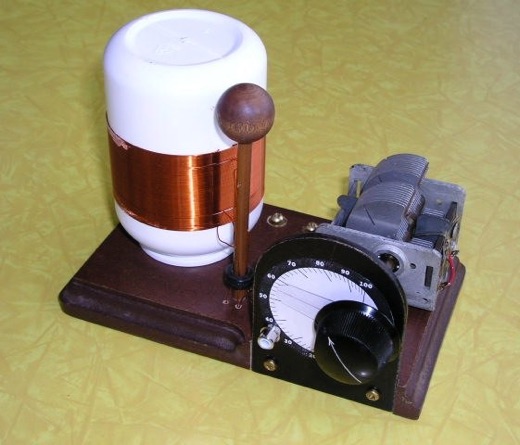
The Mystery Crystal Set, was first described in the July 3rd, 1932 Brisbane [Australia] Sunday Mail, (page 23), and is unique in the way that its main coil is wound. The original Mystery Set circuit diagram is reproduced below:

One of the more interesting characteristics of the Mystery Crystal Set is that there is no apparent signal path between the antenna and ground. The antenna is connected to the primary, while the circuit's only ground point is connected to the secondary. This set makes use of the inter-winding capacitance to complete the signal path.
The coil has the primary and secondary wound side by side (i.e., bifilar). In the original design, a 3 inch (75 mm) diameter coil form was used. The primary was close-wound 12 turns. Then, after the 12th primary turn, the winding continued with the primary and secondary close-wound side by side for the next 25 turns. The secondary was then terminated, and the primary then continued on for another close-wound 13 turns. Thus, the primary has a total of 50 turns, and the secondary has 25 turns.
By means of a two position switch, the antenna could be connected to either end of the primary winding, giving either a Selective or Broad tuning characteristic. The Broad setting also gives more volume. I've reproduced the schematic as it originally appeared. However, it should be noted, that if the coil primary and secondary leads are located the way the diagram implies, then the Broad-Selective switch positions are actually backwards. I simply wired mine to be permanently in the (true) selective configuration.
It can also be reconnected so that the ground is connected to the stator of the second section of the variable capacitor (the antenna connection is to the rotor/frame). In this configuration, it is similar to an MRL#39 crystal set. This gives a further improvement to selectivity at the expense of sensitivity. So far, I haven't found this configuration to be any advantage on the medium wave band, and I expect that is because of the relatively low Q of my coil. However, in this configuration, it picks up signals in the 49 meter shortwave band, which are of some interest.
Note, that in the original coil, the secondary is not exactly centred. In order for the secondary to be centred, the total number of primary and secondary turns would have to be an odd number. When I wound my coil, using an empty vitamin bottle for the form, I made the primary 51 turns so that the secondary could be centred exactly.
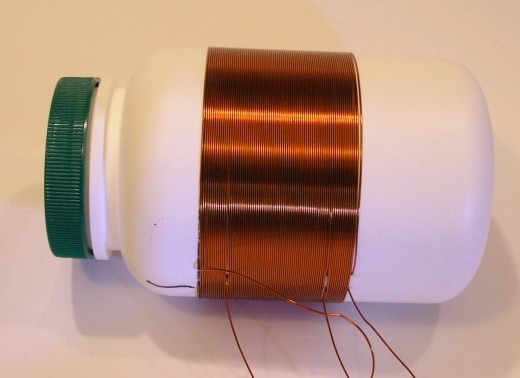
Coil specifications are as follows:
Aside from the modern materials, this is very close to the specifications for the coil in the original Mystery Set article.
For the detector, I tried several different germanium, and Schottky diodes. The best performance was with a type 1N191 germanium diode. It was even better with several 1N191's in parallel. In the end I paralleled three 1N191 diodes. I did not bother with the 0.001 µF capacitor after the detector. It serves no useful purpose, other than to increase component count. The cathode of the detector is wired to an output jack on the front panel. I use an audio matching transformer between the detector output and the headphone. The audio matching unit and headphones are shown below:
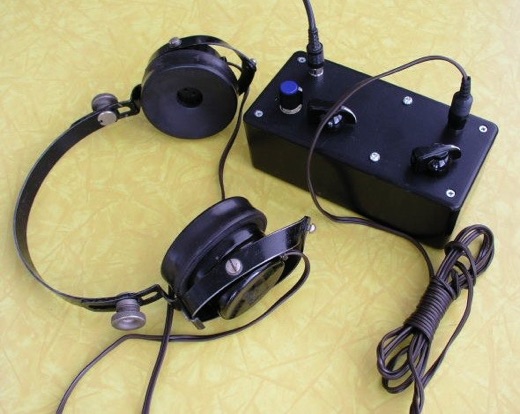
The matching unit consists of a Bogen T725 audio transformer, and two 6-position rotary switches connected to taps on the transformer. One switch selects the input tap, and the second switch selects the output tap. Also included is a 'Benny' which is used to adjust the detector's DC load to match the AC load. The control on the far left is a 100 kΩ potentiometer for adjusting the Benny's DC load. The headphones are Western Electric Model D173014 sound powered phones. The elements have an impedance of 600 ohms each, and are wired in series, for a total impedance of 1200 ohms.
As a side note, rather than the traditional 1/4" phone jacks, I've used RCA type phono connectors, as they are less expensive, and seem to make more reliable electrical contact.
Here is a rear view of the receiver.

A 6:1 reduction drive is used on the variable capacitor. Even with the low selectivity, the reduction drive still makes tuning much easier. The antenna and ground connection screws are shown at the back on the base board. The underside of the base board has been hollowed out using a router, and the wiring and detector diodes are located there. The vertical wood dowel (with the knob on top) is used as a support for the leads coming off of the coil. This is shown in more detail in the following front view:

Now, I must confess that these are rather bad construction techniques for a crystal set, if the intention is (and it should be) to get the maximum possible Q.
I used a Heathkit QM-1 Q-Meter to measure the Q of the primary (tank) side of the coil. The results are shown in the following graph:
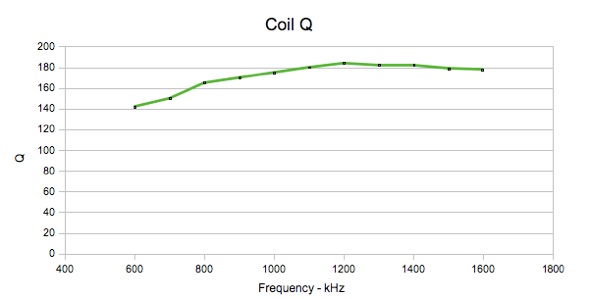
With a maximum Q of just over 180, it's certainly not a big league set, and not surprisingly, the selectivity is not particularly good. However, the sensitivity is better than I expected, and I have been able to pick up several stations more than 1000 km distant.
I entered this set in the 2012 Radioboard DX Contest, and following is my reception log:
Log Date Time Freq Call Dist Power Dist/ Location
No. (CST) kHz Sign km Watts Power City, Province/State
--- ---------- ----- ---- ---- ---- ----- ----- --------------------
001 2012-07-24 23:55 860 CBKF-2 17 10000 300 SASKATOON, SK
002 2012-07-25 00:01 650 CKOM 9 10000 300 SASKATOON, SK
003 2012-07-25 00:03 600 CJWW 12 8000 300 SASKATOON, SK
004 2012-07-25 00:05 540 CBK 94 50000 300 WATROUS, SK
005 2012-07-25 00:12 900 CKBI 126 10000 473 PRINCE ALBERT, SK
006 2012-07-25 00:14 990 CBW 687 46000 2210 WINNIPEG, MB
007 2012-07-25 00:16 1160 KSL 1326 50000 4233 SALT LAKE CITY, UT, US
008 2012-07-25 00:35 1340 CIBQ 406 1000 2030 BROOKS, AB
009 2012-07-25 00:40 1050 CJNB 140 10000 525 NORTH BATTLEFORD, SK
010 2012-07-25 00:43 1260 CFRN 497 50000 1587 EDMONTON, AB
011 2012-07-25 00:47 1140 CHRB 515 46000 1657 HIGH RIVER, AB
012 2012-07-25 03:48 1280 CJSL 428 10000 1605 ESTEVAN, SK
013 2012-07-25 03:53 1130 CKWX 1201 50000 3834 VANCOUVER, BC
014 2012-07-25 03:57 1310 KNOX 834 5000 3382 GRAND FORKS, ND, US
015 2012-07-25 04:00 1320 CHMB 1199 50000 3827 VANCOUVER, BC
016 2012-07-25 04:06 1330 CJYM 117 10000 439 ROSETOWN, SK
017 2012-07-25 11:08 1090 KBOZ 791 5000 3208 BOZEMAN, MT, US
018 2012-07-25 11:27 1500 KSTP 1269 50000 4051 ST. PAUL, MN, US
019 2012-07-25 11:32 1540 KXEL 1542 50000 4922 WATERLOO, IA, US
020 2012-07-25 11:47 1460 KLTC 646 5000 2620 DICKINSON, ND, US
021 2012-07-25 11:52 910 CKDQ 475 50000 1516 DRUMHELLER, AB
022 2012-07-26 00:01 1570 CKMW 689 10000 2584 MORDEN, MB
023 2012-07-26 00:31 940 CJGX 313 10000 1174 YORKTON, SK
024 2012-07-26 00:35 950 CFAM 702 10000 2633 ALTONA, MB
025 2012-07-26 00:37 960 CFAC 513 50000 1638 CALGARY, AB
026 2012-07-26 00:40 980 CJME 240 5000 973 REGINA, SK
027 2012-07-26 00:48 1110 KFAB 1464 50000 4673 OMAHA, NE, US
028 2012-07-26 01:03 1030 KTWO 1030 50000 3288 CASPER, WY, US
All station locations are in Canada or the United States (US locations are indicated as such).
The Dist/Power number is the Distance divided by the Logarithm of the Transmitter Power (minimum value is limited to 300), and is often used as a guideline to determine the relative difficulty of receiving the station (the higher the number, the more difficult), though this is a very rough guide, because many other factors also affect reception.
The following map shows the locations of the stations received.
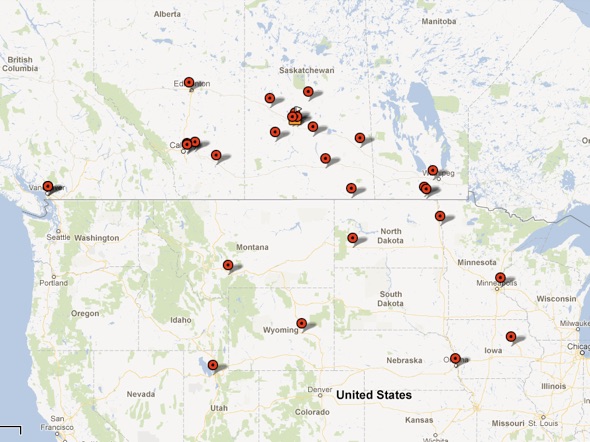
It is important to note that I have three powerful local stations at 600 kHz, 650 kHz and 860 kHz. Because of this, I was not able to pick up any distant stations in this frequency range, even when I used a series of wavetraps to attenuate the locals. This is where a more selective set would prove its worth. Still, I can't complain about the results. Though I must say that the good performance is largely due a decent Antenna/Ground system, very sensitive headphones, and good geography (my location is great for DX).
As mentioned above, it's possible to configure the antenna/ground connections as an MRL#39 set, which unintentionally made it sensitive to shortwave stations. I logged the following shortwave stations in this configuration:
Log Date Time Freq Call Dist Country, Comments
No. (CST) kHz Sign km
--- ---------- ----- ---- ----- ---- ------------------------
001 2012-07-24 23:45 6060 .... 3850 Cuba, Radio Havana
002 2012-07-25 03:14 5935 WWCR 2360 USA, Nashville, TN; Religious
003 2012-07-25 21:05 7385 WHRI 2970 USA, Cypress Creek, SC; Religious
004 2012-07-28 02:47 5000 WWV 1285 USA, Ft. Collins, CO; Time Signal
The Mystery Crystal Set, seems to be a good beginner's set, considering that it does not require any exotic components, and is quite easy to build.